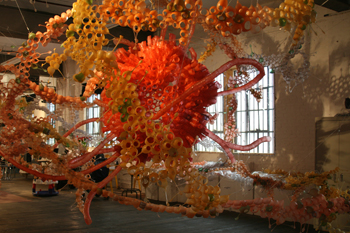The Next Step:
Gluing Down the Caps
Above is a photo of the first board
that had all of its caps glued down.
This was so fun to see!
The students loved seeing their work displayed
on the window sills of the art room.
At this stage, they were really starting to
take pride in their work and in the
project, in general.
Above is a photo of two boards matching up.
Again, the students loved seeing the mural
starting to come together, one step at a time.
Gluing down the caps provided an opportunity to
teach about some of the elements and principles of design.
I stressed to my students that in order for the mural to look
more visually interesting, they needed to choose caps
of different sizes for any given area.
This way, the caps would create a simulated look of texture.
I told my students that if they chose one size of caps for an area,
that this would look boring. I said to them, "Choose a variety of sizes
so that the mural looks more interesting!"
They did a great job with this!
Below is a photo of the mural (work-in-progress)
that was on display for the school's Art Show.
You can see here how four of the foam core pieces were
placed together on a larger board.
We used particle board from Home Depot for the larger boards.
The corner caps were screwed down to the wood
in this photo, just to keep it together.
Later, all of the caps would be screwed down (next post).
We were very lucky in that Home Depot donated two large
pieces of particle board (4' x 8'), 1/2" thick.
These are priced at $20.00 a piece!
Home Depot cut the boards down to the size you see above.
We ended up with six boards cut to this size.
Note that the spiral on the right
has different shades of blue. Arg!!
This would be remedied later
to create a sense of unity for the main spiral.
I explained to my students that the main spiral is the central
point of Van Gogh's painting, the emphasis.
Thus, it is important that this part of the mural be consistent in color.
It was hard to find enough light blue caps for this project!
Unfortunately, the best remedy I could come up with was
to spray paint the caps once they were all screwed down
Here is the end result:























.jpg)








